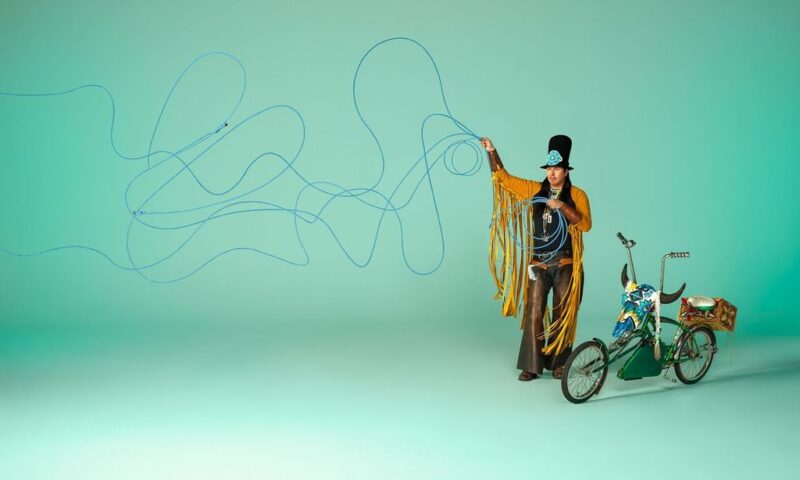Chris Attenborough has lived in the same house his whole life. It seems unremarkable at first, lined up in a row amongst similar modest bungalows off of York Road just north of the city line. The house is clad in powder-blue vinyl siding and asphalt shingles, anchored beside two cars on an asphalt driveway. Taken as a set piece, it is a near-pure expression of the American suburban dialect, down to the slightly neglected garage by the alley in back.
On closer inspection, some peculiarities announce themselves. Unlike the neighbors, there is no sidewalk splitting the front yard in half. Instead, a walk leads up one edge of the property to a pair of doors on the side of the house. One enters into the former porch, now an enclosed extension of the living room. The other reveals a staircase to the second floor, portioned off as a separate apartment. Attenborough hasn’t changed addresses much, but he has moved internally, shifting between a childhood bedroom, the upstairs apartment, and the whole house. His parents retired elsewhere and turned the property over just recently.
“This house has been in my family since 1928. When I was growing up [my stepdad] did every bit of work on this house, from the roof to the siding,” Attenborough, 31, told me over coffee. At some point, the upstairs was split off to bring in some extra income. A tiny kitchen was shoehorned into the back bedroom, and a thin wall isolated the living room from the staircase. The exterior form and internal organization rearranged in a series of gradual, accretive steps.
“Inevitably [it] became a very authentic space,” Attenborough says. That handyman’s idiom has informed his work ever since, a series of pieces that explore space, place, and the rustic language of homemade structures.
Attenborough went to Towson High School and picked up photography, a practice he followed through to MICA, earning his degree in 2005. His undergraduate work included photographs of Canton and East Baltimore, just as it was undergoing a wave of investment. While in school, he also visited Ireland over several summers. “I was still trying to understand how the world is put together physically, y’know? I would go there [and] this clichéd Ireland thing would happen where all the sudden my work was pictures of stone walls and pastures. And that wasn’t my work.” After college, he spent a few years bartending, constructing furniture, and building restaurant interiors, including the first Artifact Coffee. But Ireland still held a place in his imagination, and he returned for graduate school at the Burren College of Art in 2007.
The first semester started with a two-week survey course with each head of department: sculpture, painting, performance, and photography. Each was very different, allowing Attenborough to experiment with different modes of working. As a Baltimorean in a foreign land, his first independent project followed up on his Irish classmates’ fascination with The Wire. “I’d see a landscape-ish scene, screen capture, then take that in and Photoshop [the actors] out.” Then, he’d further re-process the pictures by piping them back through old tube-based televisions and photographing the screens. The final images digitally dissolved the characters until their stories were distilled into ragged, desolate space.
While working on that project, Attenborough met Sean Naftel, now 39, a fellow American and his current artistic collaborator. Both had begun toying with Google Earth, a new program at the time, and were fascinated with the glitches in the software.
“Sean and I had started talking about this idea of place: how place is established, how we generate an idea of that, how that’s separate from space,” Attenborough said. They found Ireland to be a distorted echo of America, replete with McDonald’s, Exxon, and roadside Coke bottles, all marooned on moors to near-comic effect. It seemed strange they would have traveled so far from home and yet be surrounded by the same forms, rendered in a new accent.
One of their first pieces together inverted this idea, attempting to knit together an environment at once globalized and so hyper-local it was un-replicable. They called it the Git Inn, and based it loosely on a strange pub in a strange town called Gort.
“Everything got pulled in there and bolted to the walls for the past 75 years,” Attenborough said. “People would be in there drinking pints of milk. Just a very weird place.” Naftel and Attenborough built a bar in the gallery, furnished with items found within a ten-mile radius. They served a homemade blend of cheap Scotch, bourbon, and Irish whiskey re-bottled in their own re-labeled salvaged containers. Around the perimeter of the room, near the ceiling, Attenborough hung a series of pixelated gas-station portraits as a stylized border between ground and sky. In the corner, a booth gave away free art, a motif that would recur in many later pieces. “That piece was when it really clicked, that ‘this is where we’re going,’” Attenborough told me. He and Naftel have been collaborating consistently ever since.
After school, back in America, Attenborough picked up where he left off, bartending and working for the Contemporary Museum. He and Naftel constructed a series of installations for Artscape. The first year, in 2010, they fabricated a small film studio with Jim Lucio that captured, edited, and re-played videos of people in the crowd. In 2011, they acquired a 1975 Winnebago Indian and transformed it into a mobile studio that created replicas of art from the early 1980s.
Each reproduction was based on pages ripped out from old Art Forums and sold on a barter basis. Proceeds from the Artscape productions were used to partly finance a pop-up gallery project, Plywood, in a vacant storefront in Belvedere Square. Naftel and Attenborough also maintained a curatorial practice, Roving Project, staging temporary shows in “slack spaces” in four countries. “But, while we were doing that, we had this Winnebago that was sitting up at my parent’s house in Pennsylvania that they were not happy about,” Attenborough told me, laughing.
It all came to a head one weekend. “All this stuff was broken in it, nothing worked really,” he said. “So we just ripped out the whole interior. The thing lifted six or eight inches.” Attenborough had started going to Raven’s tailgates, and began to think about making a party bus – first as an amenity for his friends, but, the longer he thought about it, as an incredibly strange cultural artifact. People maintain special-purpose vehicles, packed with contraptions, for use on only eight days a year. Watching the game became a mass public ritual, complete with a set of devotional actions. However, the other way to watch football was a completely opposite experience – sequestered in a “man cave” with a few friends or even alone. Using the shell of the Winnebago as an armature, Attenborough and Naftel nested one experience inside the other, building a mobile man cave replete with hardwood floors, a wet bar, a urinal, and hidden compartments with vintage copies of Playboy.
Like all their pieces, Tailgate Man Cave had a participatory aspect. Over a series of months, they tailgated random events: going out to dinner, a friend’s birthday, art openings. The intent was to inject a sense of ritual into otherwise unremarkable social events, and maybe take some air out of the self-seriousness of football fans. But, after awhile, lacking a place to store it and the funds to keep up with insurance and maintenance, they tried to sell it in order to finance their next project. Discarding its identity as an art object, they posted it on Facebook tailgate forums and Ravens fan pages, but they couldn’t find a buyer. So they gutted it again.
“A lot of our joking has to do with this suburban lifestyle,” Attenborough said, explaining the tropes of the exurban male by way of his possessions. When newly married, but childless, the party bus with built-in urinal is a pocket of male freedom in an increasingly domesticated life. Eventually, the wife puts her foot down and the tailgate platform is replaced with a camper for wholesome weekend trips with the family.
Attenborough and Naftel followed the same timeline, transforming the Winnebago again into a retro-slick camper with bunk beds, camping implements, and fully-functioning bathroom. They created a suite of images around the RV, including an impeccable scale model and fake advertisements. On April 18th, on an unusually chilly night, they raffled it off at Union Brewery. The show had food, a roaring open bar, and an atmosphere charged with the knowledge that someone was driving home an antique Winnebago.
Since then, they’ve kept moving, staging a show at the DeBuck Gallery in Chelsea called Yard Sale. Filled with oddities sourced from the local Craigslist, the show has garnered positive press from the likes of the New York Times and WNYC. Attenborough maintains a crowded but very organized workshop in his garage and a neat studio for deskwork in one of the spare bedrooms, snatching time to make work in between shifts at Union Brewery and teaching photography at MICA.
Now, he says, the pair is trying to “narrow down what our materials are and hone in on an aesthetic. One of the things that we always talk about is if you were walking through the woods and all of the sudden you came across an ATM machine, you’d be like ‘what is that doing here?’ That experience.”
Author Will Holman grew up in Towson and studied architecture at Virginia Tech. Since then he has poured concrete, built cabinets, studied low-income housing, taught carpentry, and worked as a studio assistant. He recently returned to Baltimore to work as a Fellow for the Robert W. Deutsch Foundation. Find him on Twitter @objectguerilla. Views expressed in this article are his own.













